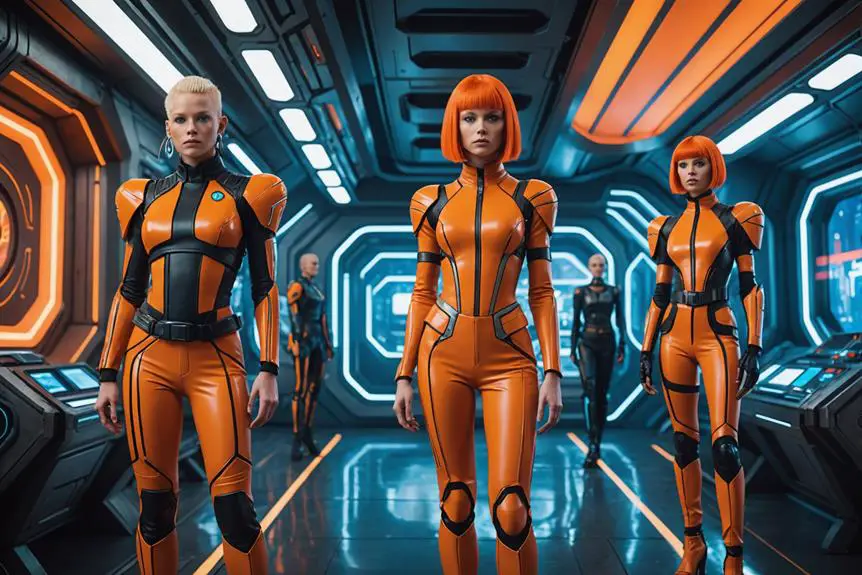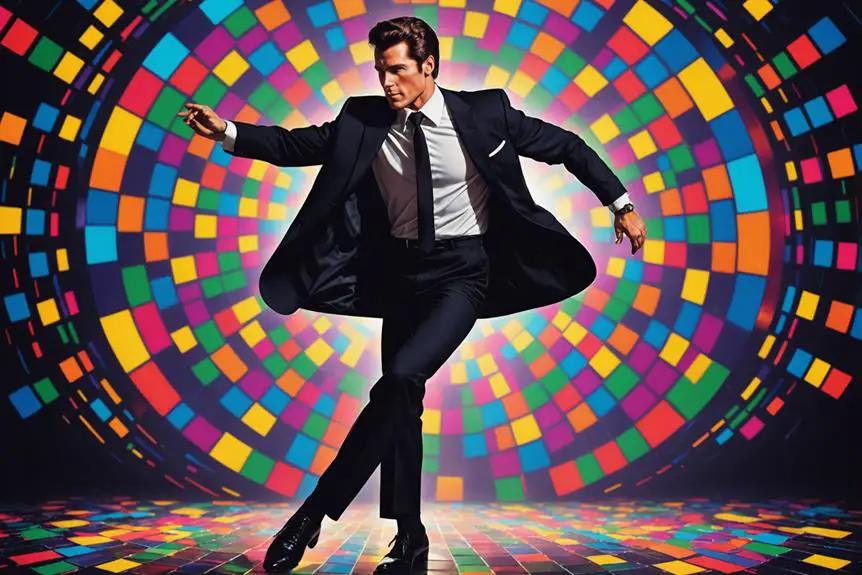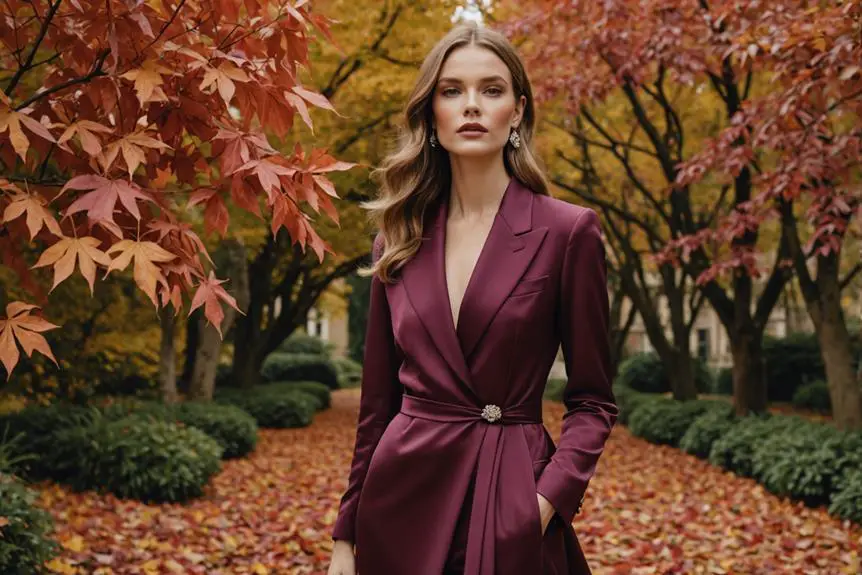You might think movie outfits don't greatly impact a film's legacy, but in *The Fifth Element*, they absolutely do. Designed by Jean Paul Gaultier, the costumes not only define characters but also create an unforgettable futuristic aesthetic that resonates today. From Leeloo's striking bandage bodysuit to Ruby Rhod's flamboyant jumpsuits, each ensemble tells a story of its own. As we explore these iconic outfits, you'll discover how they've shaped pop culture and influenced modern fashion in ways you might not expect. What hidden meanings lie behind these bold choices?
Overview of The Fifth Element
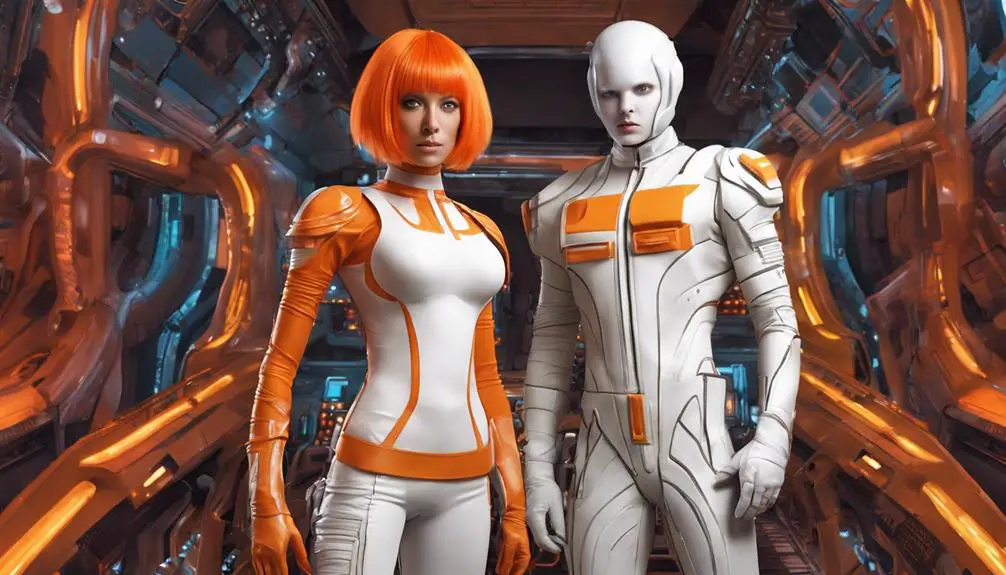
*The Fifth Element* bursts onto the screen with a unique blend of sci-fi, action, and comedy that captivates audiences. Released in 1997 and directed by Luc Besson, this film quickly became known for its striking visual style and diverse cultural influences.
Set in a vibrant futuristic world, you follow ex-military taxi driver Korben Dallas, played by Bruce Willis, as he teams up with Leeloo, a mysterious being portrayed by Milla Jovovich. Together, they set out on a thrilling quest to retrieve four mystical stones essential for humanity's survival.
Despite mixed reviews upon its release, *The Fifth Element* has gained cult status, celebrated for its creativity and fast-paced narrative. While some critics pointed out the film's incoherent plot, many fans appreciate its strong visual aesthetic and character design, particularly the innovative costume design by Jean Paul Gaultier.
His bold, retro clothes not only define the film's unique style but also reflect its playful yet intense tone. As a groundbreaking sci-fi film, *The Fifth Element* continues to influence the genre, leaving a lasting impression with its unforgettable characters and imaginative world.
Costume Design Highlights
Jean Paul Gaultier's visionary costume design for *The Fifth Element* not only brought the film's vibrant world to life but also pushed the boundaries of fashion and storytelling.
With over 1,000 unique costumes crafted—amounting to ten fashion collections—Gaultier showcased his unmatched creativity. He produced around 5,000 sketches before finalizing designs, emphasizing his commitment to innovation.
Incorporating non-traditional materials like plexiglass, rubber, and neoprene, Gaultier blended futuristic aesthetics with unconventional fashion concepts. Take Leeloo's iconic bandage bodysuit, which symbolizes both vulnerability and strength, sparking a wave of cosplay and Halloween tributes.
On the other hand, Ruby Rhod's flamboyant costumes, especially his standout leopard print jumpsuit, amplify his eccentricity while satirizing the entertainment industry.
These costumes serve as more than just visual flair; they comment on evolving gender norms, with many outfits blurring traditional gender lines through androgynous designs.
Gaultier's work not only captivated audiences but also left an indelible mark on the fashion world, proving that costume design can play an essential role in storytelling and cultural commentary.
Iconic Outfits of Leeloo
Stepping into the shoes of Leeloo, you instantly encounter a character defined by boldness and resilience through her iconic outfits. Her striking ensemble, featuring orange suspenders, gold leggings, and a daring crop top, perfectly encapsulates her vibrant personality.
But it's her initial costume, the bandage bodysuit, that truly steals the spotlight. Made from restraints, this outfit symbolizes both her vulnerability and strength, embodying the innovative vision of designer Jean-Paul Gaultier, who famously embraced the concept of underwear-as-outerwear.
Director Luc Besson's creative direction guarantees that Leeloo's fashion choices, especially her bright orange hair, blend futuristic aesthetics with a sense of empowerment. Each of her iconic outfits not only showcases her unique style but also highlights her evolution and significance within the film's narrative, reinforcing themes of identity and resilience.
The bandage bodysuit has left a lasting impact on pop culture, becoming a popular choice for Halloween and cosplay enthusiasts alike.
Leeloo's costumes are more than just attire; they're a celebration of individuality and strength, making her one of the most memorable characters in cinematic history.
Ruby Rhod's Unique Style
While Leeloo captivates with her empowering looks, Ruby Rhod, played by Chris Tucker, takes flamboyance to a whole new level. His costumes in the film are a dazzling display of vibrant colors, bold patterns, and eye-catching accessories. The iconic leopard print jumpsuit you can't miss perfectly enhances his over-the-top personality, making Ruby a memorable pop culture icon.
Ruby's flamboyant fashion is more than just eye candy; it serves as a satirical commentary on the entertainment industry of the future. His style boldly challenges traditional gender norms, symbolizing fluid gender performance and aligning with the film's themes of androgyny and non-conformity.
Each outfit, from his striking hairstyles to his elaborate cane, contributes to an overall visual impact that's both humorous and thought-provoking.
Interestingly, original casting considerations for Ruby included Prince, highlighting the character's intended flamboyance and the influence of pop culture icons on his design.
Ruby Rhod's unique style encapsulates a world where fashion isn't just a statement but a vibrant form of social critique, challenging norms and inviting viewers to embrace individuality in all its flamboyant glory.
Dallas's Costume Evolution
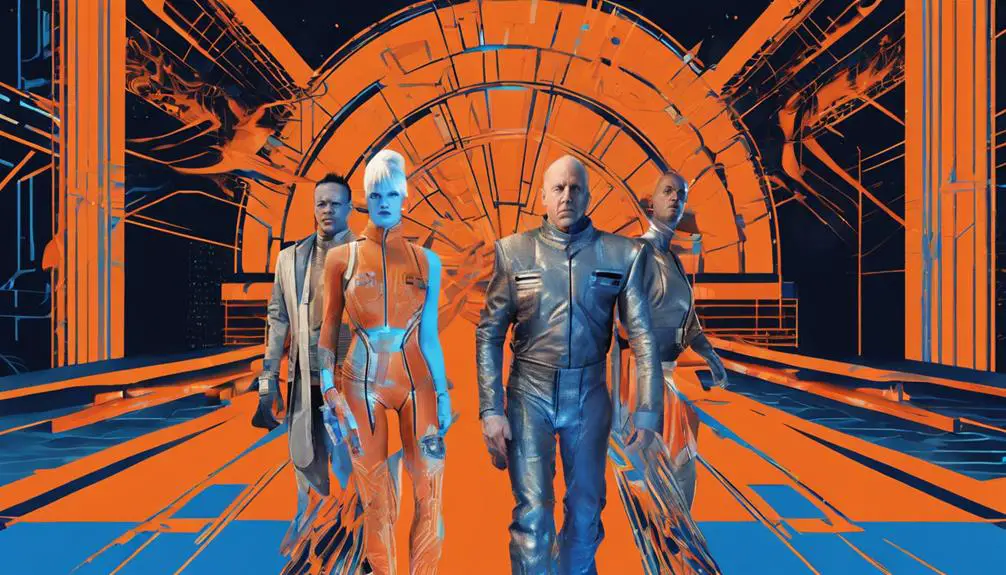
Korben Dallas's costume evolution in *The Fifth Element* showcases a dynamic progression that reflects both his character development and the film's vibrant aesthetic. At first, you see him in a striking shirtless appearance that quickly shifts to an eye-catching orange rubber vest, emphasizing the film's thematic orange color motif. This choice of color symbolizes energy and alertness, setting the tone for Dallas's rugged ex-military persona.
As the story unfolds, Dallas's signature outfit emerges: a cargo jacket with asymmetrical padding and cut-off sleeves. This design not only highlights his tough exterior but also nods to Bruce Willis's iconic roles, particularly the ribbed orange tank top reminiscent of *Die Hard*.
The evolution of outfits doesn't stop there; it culminates in a tuxedo that, during the film's climax, becomes shredded, serving as a powerful visual metaphor for his journey and resilience.
Throughout this change, the costume designer skillfully intertwines style with narrative, creating a memorable wardrobe that resonates with the audience. Dallas's costumes aren't just clothing; they're a reflection of his growth, making every outfit change significant in the context of his character arc.
The McDonald's Girls' Fashion
In *The Fifth Element*, the McDonald's Girls' fashion stands out with its playful yet striking design, setting it apart from typical fast-food uniforms. Crafted by the visionary Jean Paul Gaultier, their outfits feature red strapless mini dresses adorned with yellow trim, embodying a futuristic aesthetic that captures attention.
These playful costumes serve not only as eye-catching attire but also as a commentary on societal norms within the film's unique world-building. The vibrant color scheme and flirtatious design elements elevate the McDonald's Girls beyond mere service roles, adding layers of humor and critique to consumer culture.
By showcasing these bold outfits, the film pushes boundaries, challenging viewers to reconsider traditional expectations of fashion and identity in a futuristic setting. Each detail, from the fit to the accessories, reflects Gaultier's meticulous craftsmanship, ensuring these characters leave a lasting impression.
Through their distinctive fashion, the McDonald's Girls contribute to the film's overall narrative, creating memorable visual moments that engage the audience and enrich the viewing experience. Their playful costumes not only enhance the film's aesthetic but also invite viewers to explore deeper themes woven throughout the story.
Cultural Influences in Costumes
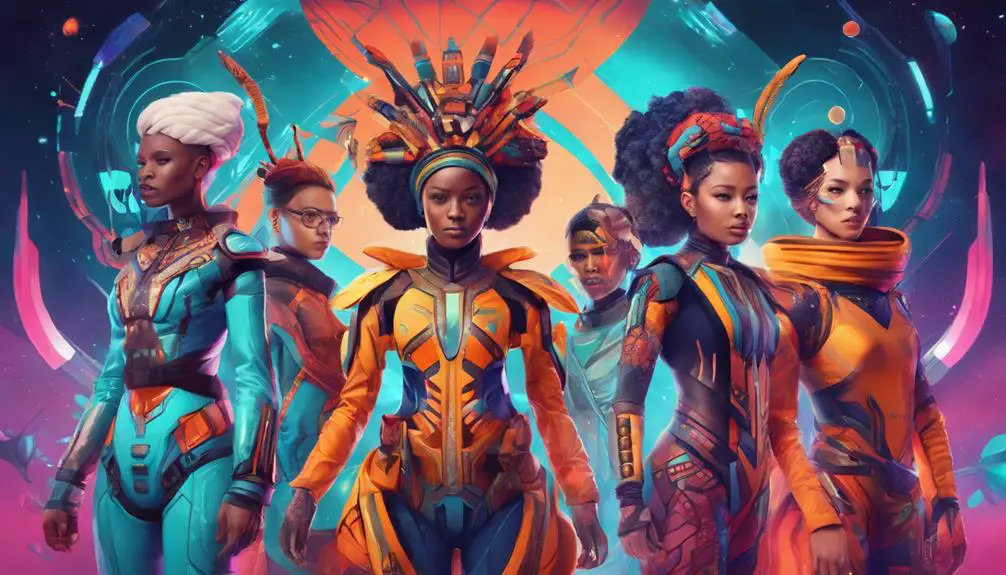
The vibrant costumes in *The Fifth Element* reflect a rich tapestry of cultural influences that shape the film's distinct visual identity. Designed by the iconic Jean Paul Gaultier, the costumes for the film brilliantly combine elements from punk rock, bondage aesthetics, and 90s fashion trends. This eclectic mix not only establishes character identities but also serves as a commentary on cultural evolution and globalization.
For instance, Zorg's iridescent suits showcase a playful dialogue between past and future styles, while Leeloo's bandage dress captures a unique blend of high fashion and utilitarian design.
Ruby Rhod's flamboyant outfits push the boundaries of gender fluidity, reflecting the evolving views on masculinity and femininity during the 1990s. His theatrical attire is a bold statement that resonates with the film's overall theme of breaking traditional norms.
Even the inclusion of McDonald's girls in futuristic uniforms offers a humorous yet critical take on societal roles, merging contemporary fast-food culture with high fashion. Together, these cultural influences create a visually stunning and thought-provoking narrative, inviting you to explore the intersections of fashion, identity, and society in this unforgettable cinematic experience.
Lasting Impact on Fashion
With its bold aesthetic and innovative designs, *The Fifth Element* has left a lasting impact on the fashion world. Jean-Paul Gaultier's costume design brilliantly blended historical and futuristic elements, inspiring contemporary designers like Jeremy Scott and Alexander McQueen to incorporate similar themes in their collections.
You can't ignore the film's iconic looks, especially Leeloo's bandage dress and Ruby Rhod's flamboyant outfits; these styles have become staples in cosplay and Halloween costumes, showcasing their cultural significance.
Even after 25 years, *The Fifth Element* continues to influence fashion campaigns, with brands embracing its futuristic style in their marketing materials. The film's characters, adorned in bold colors and unconventional materials, challenged traditional gender norms, pushing boundaries in the 1990s and sparking conversations about how fashion defines identity.
The innovative costume design hasn't only captivated audiences but also transformed the landscape of sci-fi fashion, making it a subject of study in fashion critiques.
As you explore the lasting impact of *The Fifth Element*, you'll see how its visionary approach continues to shape modern fashion, inspiring creativity and encouraging the celebration of individuality in style.
Frequently Asked Questions
Who Designed the Clothes for the Fifth Element Movie?
Like a vibrant tapestry, the costume design for the film springs from Jean Paul Gaultier's innovative vision. His designer collaboration brought character outfits to life, blending futuristic styles, bold color palettes, and rich cultural references, influencing fashion profoundly.
What Aesthetic Is the Fifth Element?
The aesthetic blends futuristic fashion and cultural influences, showcasing bold color symbolism and character representation. Sci-fi themes emerge through iconic hairstyles and visual storytelling, creating a unique environment that challenges norms and captivates viewers.
What Does the Girl in Fifth Element Say?
In *The Fifth Element*, Leeloo's quotes, like "Leeloo Dallas multipass," create iconic lines that define memorable moments. Her dialogue impacts character insights, fueling film analysis and sparking various fan interpretations of her unique journey and alien perspective.
What Is the Diva Singing in the Fifth Element?
In the Diva's performance, you witness an alien opera that highlights her vocal techniques and the scene's impact. The costume symbolizes otherworldly beauty, enhancing the musical significance and cultural references throughout this pivotal moment.
